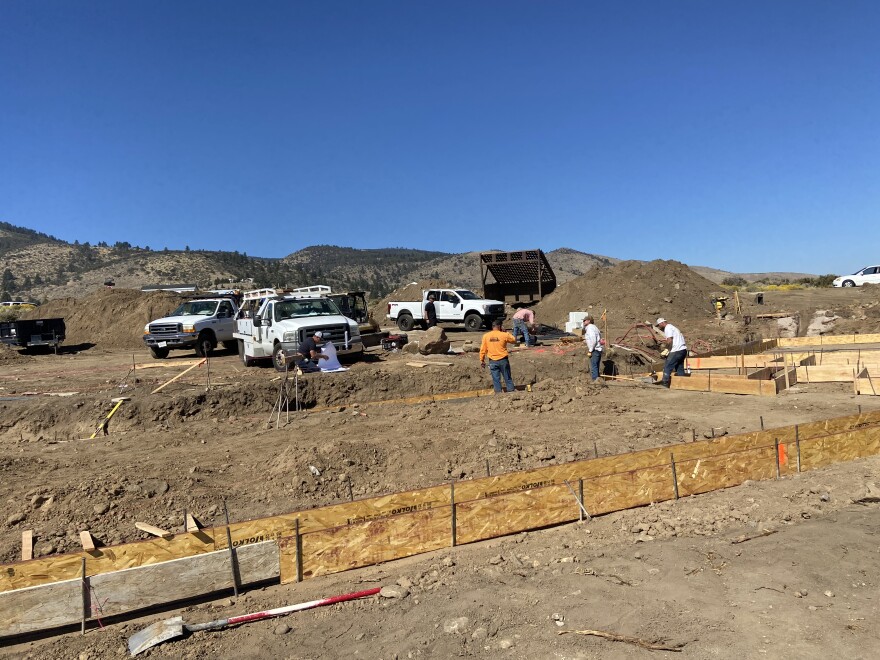On a recent blue-skied morning, high in the hills of south Reno, Nevada, a construction crew bent steel rebar for the foundation of a new house. They used a machine about the size of a microwave.
“You see how quick that went?” said Peter Picetti, owner of PF Picetti Construction, which is building the 4,000-square-foot home. “I mean, they just bent a 20-foot piece of No. 5 rebar with two 120-degree angles to fit this crazy little corner right here.”
The property has sweeping views of the forested mountain ranges surrounding it and the sprawling cityscape below.
“It’s objectively beautiful. It’s a very attractive place to be,” Picetti said.
The home is being built in what’s called the wildland-urban interface, or WUI – commonly known as the “wooey.” That’s where wildlands and development collide.
It’s also where wildfire risks are the highest.
In 2020, there were more than 44 million homes in these zones across the country, according to new research from the U.S. Forest Service and the University of Wisconsin-Madison. In fact, nearly a third of the nation’s homes are in the WUI.
“It’s concerning the fact that we continue to grow in high wildfire risk areas, rebuild in high wildfire risk areas, assuming that a wildfire won't occur,” said Kimiko Barrett, a wildfire researcher with the Montana-based research group Headwaters Economics.
Since 2005, wildfires have destroyed more than 97,000 structures, according to Barrett’s research. Last year, Colorado lost more than a thousand houses in the Marshall Fire – the most destructive in the Mountain West to date. Those homes, Barrett said, weren’t even considered to be in the WUI.

She added that many homes in high-risk areas are still being built, framed, and sided with wood.
“And then you place that in a very dry, overstocked forest – guaranteed that home is going to start burning if exposed to enough heat,” Barrett said.
That’s most visible in the West, where more than 16 million homes are in fire-prone areas, as the UW-Madison data shows. In Colorado, the amount has nearly doubled since 1990 to more than a million homes. In Nevada, it’s more than tripled to over half a million.
That’s dangerous, said Brian Bonnenfant, who studies housing supply at the University of Nevada, Reno’s Center for Regional Studies.
“It’s really been the last 10 years of this extended drought that's really impacted our forest throughout the Sierras,” Bonnenfant said. “Now, we're starting to see those impacts through large, major, uncontrollable, aggressive fires.”
In west Reno, two fires have hit a neighborhood in the WUI zone. The biggest was the 2011 Caughlin Fire, which destroyed 28 homes and damaged 15 more.
Bonnenfant said Washoe County, where Reno is located, is changing policies to increase its fire resilience. That includes restricting building on ridges and mandating sprinkler systems for homes built far away from fire stations.
“Developers want to build in these really picturesque and beautiful spots because they get more money for that," Bonnenfant said. "There’s got to be a balance, right?”
He said developers and local governments are just starting to shift their mindsets.
Meanwhile, scientists are beginning to understand the public health impacts of wildfires in the WUI, according to a new report by the National Academies.
Report co-author Marilyn Black, vice president of the Chemical Insights Research Institute, said burnt man-made objects like cars and plastics create a toxic mixture that hangs around long after a fire.
“These sorts of toxicants can end up in ash and residue,” Black said. “And that residue can permeate the ground, it can get into our water systems, our water table, get into our water supplies.”
To what degree, however, is not well understood, according to the report. Black said that’s why state and federal agencies need to fund further studies and develop new modeling tools for mitigating health risks to communities.
Back at the construction site, Picetti said he doesn’t anticipate demand for homes in picturesque spots like this to slow down.
Around Reno, a 2013 ordinance requires new homes built in fire-hazard areas to have 30 to 100 feet of defensible space. Picetti works with homeowners to comply, but still, he said, destructive wildfires will reach some of these neighborhoods in the WUI no matter what builders and homeowners do.
“Fires are gonna be, have been, and will continue to be a big part of destruction of property,” he said. “And the more we build up here, the more structures will be at risk.”
This story was produced by the Mountain West News Bureau, a collaboration between Wyoming Public Media, Nevada Public Radio, Boise State Public Radio in Idaho, KUNR in Nevada, the O'Connor Center for the Rocky Mountain West in Montana, KUNC in Colorado, KUNM in New Mexico, with support from affiliate stations across the region. Funding for the Mountain West News Bureau is provided in part by the Corporation for Public Broadcasting.
Copyright 2022 KUNR Public Radio. To see more, visit KUNR Public Radio.








